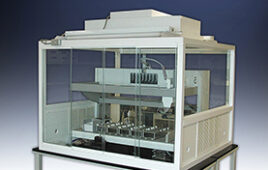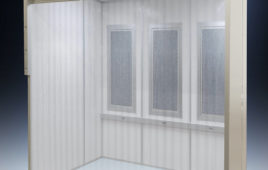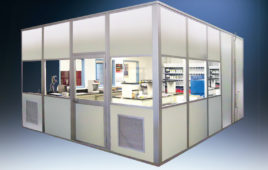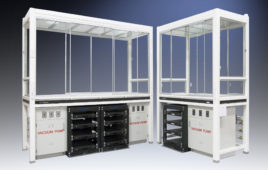According to the Centers for Disease Control and Prevention (CDC), close to 8 million healthcare employees in the U.S. alone are potentially exposed to hazardous drugs (HDs) every year.1 When improperly managed, drugs such as chemotherapy medications, antiviral drugs, hormone agents, and more can cause severely adverse health effects. These include both acute and chronic conditions, ranging from skin rashes, infertility, spontaneous abortions, and congenital malformations to cancers and immune disorders.
While the risks associated with the improper storage and handling of HDs is well-known, previous regulations have failed to provide a comprehensive set of guidelines that covers the spectrum of drugs within the purview of specialist pharmacists. In 2008, the United States Pharmacopeia (USP) sought to address this need in an update to USP <797>, but the amendments primarily focused on parenteral hazardous drugs and lacked sufficient guidance for nonparenteral products. Efforts to create a new set of guidelines began a few years later in March 2014, finally coming to fruition in February 2016 as what is now known as USP General Chapter <800>.2 Under these new guidelines, pharmacies, hospitals, patient treatment centers, and physician practice facilities are required to meet new, more rigorous environmental and safety criteria to reduce potential risks to healthcare workers and their patients, with a key aspect of the regulations related to the storage of products in cleanrooms.
The Dec. 1, 2019 compliance date may seem far away now, but it is critical that all affected facilities begin to assess their current environments, particularly cleanrooms. For some, the new requirements could mean major renovations to these areas or other changes that may impact workflow, processes, and purchasing decisions. One area of concern for pharmacists and pharmacy managers will be refrigeration, as these more stringent regulations on the storage of hazardous drugs mean a compressor-based, pass-through refrigerator will no longer be acceptable to ensure compliance.
Rethinking refrigeration
Today, many facilities use legacy refrigerators with compressor systems. These units have always presented a variety of complications for healthcare facilities, especially cleanroom environments, with contamination being a primary concern. The mechanical forces associated with their operation can often create friction, causing the systems to wear down with use and dispel particulates into the air over time. In addition, the compressors’ close proximity to the condensation trays can often promote mold and fungus growth, disrupting the once-sterile atmosphere.
Under USP <800>, all hazardous drugs must be stored and compounded in externally ventilated, negatively pressured areas with at least 12 air changes per hour. Specifically, refrigerated antineoplastic hazardous drugs must be kept in a dedicated refrigerator which, if positioned in a negative-pressure buffer room, should have an exhaust adjacent to the compressor to minimize contamination and remove airborne particles generated by the device.
Meeting the above standards could mean a significant investment in planning and construction to accommodate a conventional refrigerator to store pharmaceuticals, as it will involve specific design changes to house the troublesome compressor outside the controlled environment and ensure external ventilation. An alternative solution some organizations may consider is placing the conventional refrigerator outside of the controlled environment altogether.
While this could mitigate construction costs, which would likely pose a serious financial burden for many organizations, doing so could dramatically reduce workflow efficiency. Utilizing this type of system, personnel would be required to remove their protective clothes every time a product is needed, retrieve it from the external refrigeration, and then re-apply the protective gear to re-enter the cleanroom — a time-consuming and frustrating process that is sure to hinder operations and patient care, and also enhance overall risks of contamination.
The placement restrictions associated with compressor-based units are just one of the many challenges they pose to cleanrooms. Another is heat. As anyone who has encountered a refrigerator will know, the mechanical components in a compressor can get hot. This causes elevated temperatures within cleanrooms. Not only does this force HVAC systems to work in overdrive, creating an inefficient operation and raising energy costs, it creates an environment not up to par with USP regulations, which require that cleanrooms maintain a temperate of no more than 20 degrees Celsius and a humidity of no more than 60 percent. Furthermore, legacy refrigerators can pollute the ears as well as the air — creating a noisy environment considered distracting and potentially dangerous for employees exposed to it for long periods of time.
Compressor-based units can also be challenging to clean, as they are composed of a variety of coils and electrical panels that trap dirt and contaminants, making them hard to effectively sanitize. Additionally, wheel-less refrigerators can pose an even greater danger, as they can inhibit cleaning underneath the unit. Traditional refrigerators also have cracks and crevices in the interior shelving and drawers that are difficult to reach and facilitate microbial growth.
Despite being the leading contributor to contamination, heat output, and noise in cleanrooms, traditional compressor-based refrigerators have always been considered unavoidable. However, with new standards making what was once a “necessary evil” subject to intense scrutiny that could result in State Board fines, suspensions, or even license loss, it’s time for pharmacists and mangers to look to a new solution.
Simplifying cleanroom-compatible refrigeration
Fortunately, advances in thermoelectric technology are offering innovative solid-state alternatives to the conventional refrigerator that can ease the compliance process for facilities. These benefits come largely from the removal of the compressor and any mechanical parts, which creates a quieter, cleaner, and more dependable storage solution.
The absence of these components means these units are cleanroom-ready right out of the box, as they do not require any added measures or costly construction steps to accommodate external ventilation. These units, which channel heat up to a high-performance thermoelectric heat pump that cools the refrigerant and transfers the heat into the ambient environment, can simply be placed into the compounding cleanroom for immediate use, ensuring all necessary drugs are within easy reach of personnel. This not only saves significant renovation expenditures, but ensures quick and easy compliance without any delays or hindrances to workflow.
The removal of mechanical parts also ensures lower heat output, with solid-state units conserving as much as 40 percent more heat energy than conventional alternatives. This reduction in heat emission increases placement options within a cleanroom and helps facilities stay within the room temperature and humidity ranges mandated by USP <800>. In doing so, solid-state units create a cooler and more comfortable working environment for employees and a safer environment for sensitive drugs — all while improving overall efficiency and making it easier for a facility’s HVAC system to maintain stringent environmental controls.
An absence of mechanical parts also means no more vibration, enabling near-silent operation. This eliminates several problems associated with traditional units, such as mechanical failure. Since solid-state units have no mechanical components, they are more reliable. They also do away with the need for grease or oil, eliminating the risk of particulate contamination and the growth of mold, fungus, and bacteria. Furthermore, a lack of mechanical parts means the unit requires minimal maintenance, as there are fewer moving parts that will weaken and fail over time. Cleaning a solid-state refrigerator is much easier as well, since the design does not include a difficult-to-reach, statically charged compressor to decontaminate. This translates to less preventive maintenance, increased dependability, and simpler service and repair, when needed.
As the healthcare industry continues to improve its standard of care, it’s crucial that pharmacies, hospitals, patient treatment centers, and physician practice facilities reevaluate their processes, including how they handle and store hazardous drugs. Refrigeration will continue to play a vital role in the healthcare system, making it imperative that these facilities invest in new solutions now that will allow them to keep pace with the more stringent regulations of tomorrow. Fortuitously, advances in cooling technology are bringing sorely needed upgrades to the dated practice of refrigeration just in time — providing systems that overcome the inefficiencies of their predecessors to deliver more precise cooling in a cleaner, more mobile, and more reliable form factor.
References
1. https://www.cdc.gov/niosh/topics/hazdrug/default.html
2. http://www.usp.org/compounding/general-chapter-hazardous-drugs-handling-healthcare
Jerilin Kenney is Vice President and General Manager of Life Sciences and Healthcare with Phononic, based in Durham, N.C. www.phononic.com




